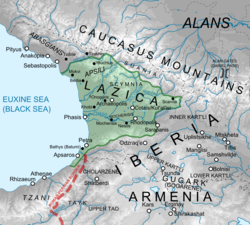حرب اللاظ
| حرب اللاظ Lazic War | |||||||||
|---|---|---|---|---|---|---|---|---|---|
| جزء من الحروب البيزنطية الساسانية | |||||||||
 خريطة لازيكا | |||||||||
| |||||||||
| المتحاربون | |||||||||
|
| |||||||||
| القادة والزعماء | |||||||||
|
جستنيان الأول يوحنا تسيبوس † داغستايوس، بساس، مارتن، جستن، گوبازس الثاني من لازيكا (بعد 548) Dabragezas Elmingir |
خسرو الأول، مهر مهرويه †, ناچوراگان، نابد Farroxan[2] Izadgushasp Fariburz گوبازس الثاني من لازيكا (541–548) Opsites of Lazica Terdetes[3] | ||||||||
حرب اللاظ Lazic War ، وتُعرف أيضاً بإسم الحرب الكولچية Colchidian War أو في التآريخ الجورجية بإسم حرب إگريسي الكبرى (بالجورجية: ეგრისის დიდი ომი، إگريسيس ديدي أومي)، نشبت بين الامبراطورية الرومانية الشرقية (البيزنطية) و الامبراطورية الساسانية للسيطرة على منطقة لازيكا الجورجية القديمة. استمرت حرب اللاظ لعشرين عاماً، من 541 إلى 562، بنجاح متفاوت وانتهت بانتصار الفرس، الذين فازوا بجزية سنوية مقابل إنهاء الحرب. حرب اللاظ مسرودة بالتفصيل في أعمال پروكوپيوس من قيصارية و أگاثياس.[4]
لازيكا
لازيكا، الواقعة على الساحل الشرقي للبحر الأسود، وتتحكم في ممرات الجبال الهامة عبر القوقاز وإلى بحر قزوين، تتمتع بأهمية استرتيجية فائقة للإمبراطوريتين. فللبيزنطيين، فقد كانت حاجزاً في وجه تقدم الفرس عبر أيبريا إلى سواحل البحر الأسود. أما الفرس في الجانب الآخر فقد كانوا يطمعون في الوصول إلى البحر الأسود، وأن يسيطروا إقليم يمكن لعدوهم منه تهديد أيبريا، التي كانت آنئذ تحت هيمنتهم الكاملة.[5]
Then, in 557, a truce ended the hostilities between the Byzantines and Persians, and by the "Fifty Years Peace" of Dara of 562, Khosrau I recognized Lazica as a Byzantine vassal state for an annual payment of gold.
خلفية
The Persian Sasanians recognized Lazica (Egrisi) as part of the Roman/Byzantine sphere of influence by the "Eternal Peace" Treaty of 532. By that time, in order to foster their influence over the local monarchy, the Byzantines had insisted on the conversion of the King, Tzath I: he received both baptism and royal attributes in Constantinople, from Emperor Justin I (Justinian's predecessor), in 522/3.[6] Byzantine garrisons were stationed in Lazica and in neighboring Abasgia, mostly in the coastal cities of Poti, Sebastopolis and Pityus. The kingdom's capital, Archaeopolis, was fortified, as well as the southern access to the kingdom on the coastal road at Petra (present-day Tsikhisdziri, north of Batumi). In 536, however, the Byzantine presence turned into a full protectorate, as the king lost many powers to the new magister militum per Armeniam John Tzibus. When Tzibus curtailed the freedom of trade of Lazic tradesmen to advance Byzantine interests, the popular dissatisfaction led to a full-scale uprising in 541, and the weakened king, Gubazes II, secretly sought Persian assistance against the Byzantines.
الحرب
Stack|

Those calls were answered that year by the Persian king Khosrow I, who entered Lazica, captured the Byzantine main stronghold of Petra, and established another protectorate over the country.[7] Khosrow I retreats to Persia a year later after an abortive invasion of Commagene. In 543, a Roman invasion of Armenia was defeated by a small Persian force at Anglon, and Khosrow I unsuccessfully besieges Edessa in Mesopotamia a year later. A peace treaty is signed in 545.[8]



In Lazica, Khosrow I's attempt to establish direct Persian control over the country and the missionary zeal of the Zoroastrian priests soon caused discontent in Christian Lazica and King Gubazes revolted in 548, this time against the Persians. Gubazes II requested aid from Emperor Justinian I and brought Alans and Sabirs to an alliance. Justinian sent 7,000 Roman and 1,000 Tzani (relatives of the Lazs) auxiliaries under Dagisthaeus to assist Gubazes, and besieged the Petra fortress, but faced tough resistance from its heavily outnumbered garrison. Persian reinforcements under Mihr-Mihroe defeated a small Byzantine force guarding the mountain passes and then relieved the besieged Petra. Lacking enough supplies, Mihr-Mihroe garrisoned 3,000 men in the fortress and marched to Armenia leaving 5,000 soldiers to supply Petra. This force was destroyed by Dagisthaeus at the Phasis river in 549. The next Persian offensive also proved to be unsuccessful with the commander Chorianes killed in a decisive battle at the river Hippis (now the Tskhenistskali). Nevertheless, the Persians manage to resupply Petra. The new Byzantine commander Bessas quelled a pro-Persian revolt of the Abasgi tribe, took and dismantled the fort of Petra after a lengthy siege and fierce fighting as Mihr-Mihroe didn't arrive in time. The latter unsuccessfully diverts his force against Archaeopolis in 551 as many of his men are lost due to a lack of supplies. However, the latter was unopposed elsewhere in the field and managed to capture Cotais and the Uthimereos fortress blocking the important roads to the highland regions of Scymnia and Souania, which were also captured by him later. In the summer of 555, he dislodged a superior Byzantine-Lazic force at Telephis and Ollaria by stratagem and forced them to retreat to Nesos. Nachoragan replaced Mihr-Mihroe as the latter died of illness shortly after.
King Gubazes quarreled with Byzantine commanders Bessas, Martin, and Rusticus, complaining to emperor Justinian. Bessas was recalled, but Rusticus and his brother John eventually murdered Gubazes. To redress this with a victory on the battlefield, the Byzantine generals launched a full-scale assault at Onoguris, which was repulsed by a small force under Nachoragan who momentarily took and destroyed the main Byzantine base at Archaeopolis, which Mihr-Mihroe had twice tried and failed to take. These defeats and the murder of the Lazic king caused a bitter feud between the Lazic and Byzantine generals. The Lazi people got the Emperor to nominate Tzathes, the younger brother of Gubazes, as their new king, and Senator Athanasius investigated the assassination. Rusticus and John were arrested, tried, and executed. In 556, the allies retook Archaeopolis and routed Nachoragan in his abortive attack on Phasis. In the autumn and winter of the same year, the Byzantines suppressed a rebellion staged by the mountain tribe of the Misimians, and finally made peace.
النتيجة
Then, in 557, a truce ended the hostilities between the Byzantines and Persians, and by the "Fifty Years Peace" of Dara of 562, The Byzantine Empire was obliged to pay tribute to Persia each year for the recognition of lazica as a vassal state of Romans by Persians.[9]
انظر أيضاً
الهامش
- ^ https://books.google.fr/books?id=B5BHDAAAQBAJ&pg=PA255&lpg=PA255&dq=lazic+war+sassanian+victory&source=bl&ots=4cR2bvuKIZ&sig=pdaK7p3o87CXFK_DtLZWiM4Ih3E&hl=fr&sa=X&ved=0ahUKEwi_1-npyKrXAhXDLhoKHVQIA2QQ6AEIVDAI#v=onepage&q&f=false,"When the war finally ended, the Persian Sasanians had triumphed, forcing the Byzantine emperor to pay 400 pounds of gold annually."
- ^ Alemany 2003, p. 5.
- ^ Procopius of Caesarea (2016). Delphi Complete Works of Procopius (Illustrated) (in الإنجليزية). Delphi Classics. ISBN 978-1-78656-373-6.
- ^ Leppin, Hartmut (2021). "The Eastern Roman Empire and Its Neighbours in the "Age of Justinian" – An Overview". In Meier, Mischa; Montinaro, Federico (eds.). A Companion to Procopius of Caesarea. Leiden, The Netherlands: Brill. p. 13. ISBN 978-90-04-49877-8.
After 545 truces brought peace to most of the border regions, but the war lingered in the Caucasus until 561, when Khosrow and Justinian finally agreed to a fifty-year peace. There was no definite victor, but the Sasanian Empire was in a slightly better position as Rome was obliged to pay a fixed sum to Persia each year.
- ^ Salia 1980, p. 113
- ^ Salia 1980, p. 114
- ^ Martindale, Jones & Morris 1992, pp. 559, 639; Bury 1958, pp. 101–102.
- ^ Bury, J. B. (2015). A History of the Later Roman Empire (in الإنجليزية). Cambridge University Press. p. 34. ISBN 978-1-108-08317-1.
- ^ Leppin, Hartmut (2021). "The Eastern Roman Empire and Its Neighbours in the "Age of Justinian" – An Overview". In Meier, Mischa; Montinaro, Federico (eds.). A Companion to Procopius of Caesarea. Leiden, The Netherlands: Brill. p. 13. ISBN 978-90-04-49877-8.
After 545 truces brought peace to most of the border regions, but the war lingered in the Caucasus until 561, when Khosrow and Justinian finally agreed to a fifty-year peace. There was no definite victor, but the Sasanian Empire was in a slightly better position as Rome was obliged to pay a fixed sum to Persia each year.
المصادر
- Alemany, Agustí (2003). "Sixth Century Alania: Between Byzantium, Sasanian Iran and the Turkic World" (PDF). Transoxiana: Journal Libre de Estudios Orientales (Transoxiana Webfestschrift Series): 1–8.
{{cite journal}}: Invalid|ref=harv(help) - Salia, Kalistrat (1980). Histoire de la nation géorgienne. Nino Salia.
{{cite book}}: Invalid|ref=harv(help) - Bury, John Bagnell (1958). History of the Later Roman Empire: From the Death of Theodosius I to the Death of Justinian, Volume 2. Mineola, New York: Dover Publications, Inc. ISBN 0-486-20399-9.
{{cite book}}: Invalid|ref=harv(help) - Martindale, John Robert; Jones, Arnold Hugh Martin; Morris, J., eds. (1992). The Prosopography of the Later Roman Empire, Volume III: A.D. 527–641. Cambridge, United Kingdom: Cambridge University Press. ISBN 978-0-521-20160-5.
{{cite book}}: Invalid|ref=harv(help)